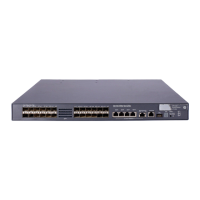67
CST
The CST is a single spanning tree that connects all MST regions in a switched network. If you regard each
MST region as a device, the CST is a spanning tree calculated by these devices through STP or RSTP.
For example, the blue lines in Figure 20 r
epresent the CST.
IST
An IST is a spanning tree that runs in an MST region. It is a special MSTI, and is also called “MSTI 0.” All
VLANs are mapped to MSTI 0 by default. As shown in Figure 20, M
STI 0 is the IST in MST region 3.
CIST
Jointly constituted by ISTs and the CST, the CIST is a single spanning tree that connects all devices in a
switched network. ISTs in all MST regions and the CST jointly constitute the CIST of the entire network. In
Figure 20, f
or example, the ISTs in all MST regions plus the inter-region CST constitute the CIST of the
entire network.
Regional root
The root bridge of the IST or an MSTI within an MST region is the regional root of the IST or MSTI. Based
on the topology, different spanning trees in an MST region may have different regional roots.
For example, in MST region 3 in Figure 21,
the regional root of MSTI 1 is Device B, the regional root of
MSTI 2 is Device C, and the regional root of MSTI 0 (also known as the IST) is Device A.
Common root bridge
The common root bridge is the root bridge of the CIST.
In Figure 20, f
or example, the common root bridge is a device in MST region 1.
Roles of ports
A port can play different roles in different MSTIs. As shown in Figure 22, an MST region comprises Device
A, Device B, Device C, and Device D. Port A1 and port A2 of Device A connect to the common root
bridge. Port B2 and Port B3 of Device B form a loop. Port C3 and Port C4 of Device C connect to other
MST regions. Port D3 of Device D directly connects to a host.

